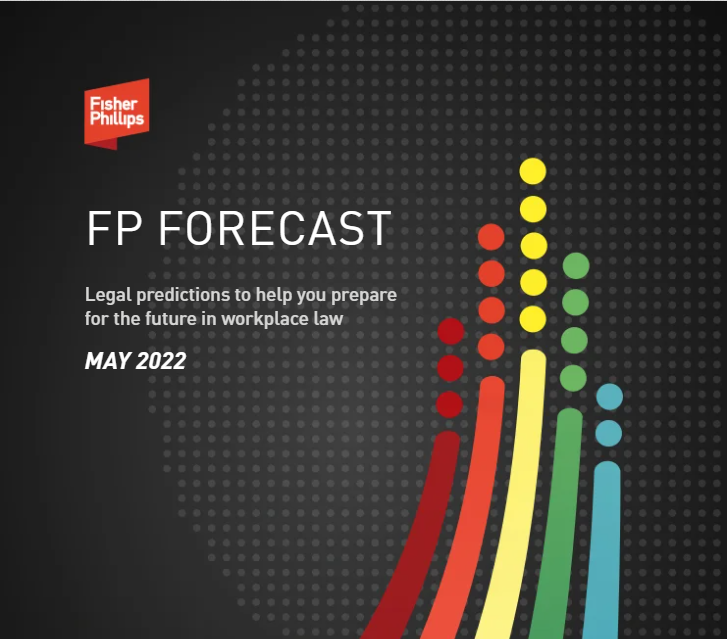FP Forecast: May 2022 Edition
Insights
5.25.22
Welcome to FP Forecast, a monthly outlook featuring Fisher Phillips thought leaders providing their insights into what employers can expect in 2022 and beyond. By following along each month, you’ll be in the best position to anticipate the expected changes and prepare your organization for what lies ahead. This month we look at the future of immigration and the gig economy – and take a special look at what healthcare employers should prepare for.
Immigration
Davis Bae, Shanon Stevenson – co-chairs of FP’s Immigration Practice Group
The New Face of Immigration
We’ve become used to the continued demand for immigrant labor – especially in today’s environment marked by near-zero unemployment and a war-torn Ukraine. But we’ll continue to see subtle changes in the types of employers relying on an immigrant workforce. No longer do we just see technology companies seeking H-1B visas. Professional services organizations will be ramping up their immigration efforts throughout 2022, as will healthcare, hospitality, manufacturing, financial services, construction, trucking, and retail warehousing businesses. But we could start seeing a swift reversal of the trend…
But Will the Brakes Soon Be Applied?
In July, the Department of Labor will issue new prevailing wage surveys – which are necessary for many types of immigration filings. We expect them to reflect inflationary pressures that most Americans have been feeling for much of 2022, which could start diminishing the demand for immigrant labor. Even if the July numbers are open to interpretation, the next release in October will surely signal a potential recession. This will cause the Biden administration to have to play a fine line between the needs of industry and overall public opinion as we look towards the midterm elections arriving in November.
Midterm Elections Will Shake Things Up
Unless a massive upheaval takes place, Republicans will win back at least one house of Congress in November, which will upend many current initiatives – immigration included. We expect to see candidates and other elected officials caught in a debate between those justifying increasing immigration visa numbers, policies, and process improvements and those operating with a backdrop of potential anti-immigrant sentiment. The end result will be that any sort of broad immigration reform will be shelved for at least two more years and employers will be once again forced to operate in an inefficient and often-confusing system.
Permanent Relaxation of I-9 Rules
Federal immigration officials recently extended relaxed I-9 rules that permit employers to conduct remote document review for new WFH or hybrid hires. Those are set to expire on October 30, but look for officials to permanently install those relaxed rules in recognition of the new world in which we all live.
Gig Economy Industry
John Polson, Rich Meneghello – co-chairs of FP’s Gig Economy Practice Group
IC Rules Will Hamstring Businesses
By the time we’ve turned our calendars from 2022 to 2023—which really isn’t that far away—two federal agencies will have released new standards for determining whether a worker is an independent contractor and an employee. And you can probably guess how this story is going to end. Look to both the Department of Labor and the National Labor Relations Board to tighten the rules and make it more difficult for you to deploy gig labor when it comes to wage and hour compliance and potential union organizing efforts. And thanks to a historic information-sharing agreement the two agencies recently forged, we will see more intensive and targeted investigative and enforcement efforts starting in the fourth quarter of 2022.
States Will Seek to Attract Gig Work and Protect Workers
But the good news is that there’s a lot of action at the state level. An increasing number of states and local jurisdictions will follow the example of Washington State, which recently enacted a new law that guarantees minimum per-trip pay rates, paid sick leave, and workers’ compensation benefits for rideshare drivers in exchange for a guarantee that the workers are classified as independent contractors. Rather than fight costly and bruising battles in court, an increasing number of government officials will reach out to gig companies to develop a win-win outcome for workers and businesses in a Washington-style compromise.
Inflation and Recession Will Lead to Further Gig Work
They say from crisis comes opportunity, and that’s exactly what’s on the horizon for companies deploying gig labor. We expect inflationary pressures to continue to mount as the year progresses, and we expect government officials to more readily use the “r-word” after federal economic reports are issued in late October 2022. That means the red-hot labor market might start to subside and you will see an increasing number of workers streaming to gig economy opportunities—either to supplement their income or as a way to bridge the time between other traditional employment opportunities. The best way that you can attract qualified workers to your gig-economy rolls in 2022 is to offer on-demand pay to get their earnings into their bank accounts as soon as possible.
Healthcare Industry
Kevin Troutman, Laurel Cornell – co-chairs of FP’s Healthcare Industry Team
Staffing Shortages Will Continue to Force Employers to Adapt
You don’t need us to forecast for you that healthcare employers will continue to feel the sting of staffing shortages for 2022. You’re feeling it every day. Unfortunately, we don’t see it easing up any time soon, so your organization will continue to need to adapt in order to thrive.
It’s a good idea to recap some of the themes we expect to continue and emerge in 2022 so you can understand how to best position your business.
- Whether it’s called burnout, “covid fatigue” or something else, the pandemic has intensified what were already high-stress jobs, where workers shoulder responsibility for patient welfare every day. On top of that job pressure, a high proportion of your employees also have personal caregiver responsibilities adding another layer of stress.
- These high-stress jobs have highlighted the need to provide support and assistance for employees who are struggling with mental health or substance abuse challenges. A recent FP Flash Survey revealed that mental health concerns impeded the retention efforts of 70% of healthcare organizations.
- Nurses and other allied health professionals are retiring or leaving their careers faster than schools can produce new professionals. Pressing needs also exist for qualified ancillary professionals such as physical therapists, pharmacists, imaging technicians, qualified patient care assistants, and other support staff.
- Nurse staffing agencies, traveling nurse agencies, and other third-party arrangements are competing with you for qualified workers.
So what can your organization do about it in 2022?
- Employers who can be most responsive to the workers’ needs, without sacrificing quality standards, will gain invaluable advantages.
- Keep your workers engaged by providing more flexible and creative mental health resources, scheduling practices, and leave policies that are more effective and accommodating than those that existed before the pandemic.
- Avoid questionable, gimmicky, or prohibited practices that some third parties may approach you with as a way to lure workers (such as so-called “independent contractor” relationships) as they are often fraught with legal and financial risks.
- At the same time, you may do well to offer online scheduling and other apps that can facilitate staffing—especially for hard-to-fill night and weekend shifts (though be mindful of potential reimbursement requirements under state law as well as the possible wage and hour implications associated with the use of such apps). Further, remain alert for technological and systemic opportunities to extend the effectiveness of employees. Telemedicine serves as an example, but you can also simply examine whether a registered nurse is indeed required to perform a particular function when a vocational nurse might be able to do it just as effectively without sacrificing quality or raising licensure issues.
Conclusion
We will deliver monthly FP Forecast insights forecasting what to expect across the entire spectrum of workplace law over the entire course of 2022, so make sure that you are subscribed to Fisher Phillips’ Insights to get the most up-to-date information direct to your inbox. If you have further questions, contact your Fisher Phillips attorney or the authors of this Insight.
Related People
-
- Davis C. Bae
- Regional Managing Partner
-
- Laurel K. Cornell
- Regional Managing Partner
-
- Richard R. Meneghello
- Chief Content Officer
-
- John M. Polson
- Chairman & Managing Partner
-
- Shanon R. Stevenson
- Partner
-
- A. Kevin Troutman
- Senior Counsel






